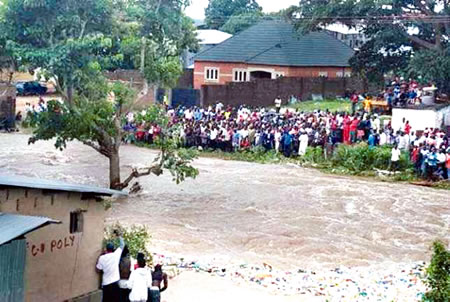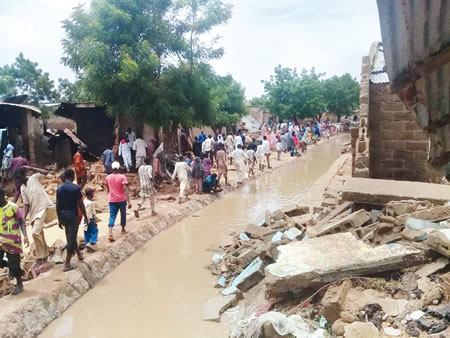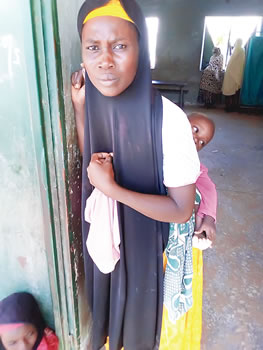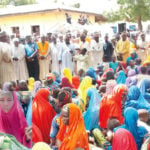IT was obvious that the vice-president, Professor Yemi Osinbajo did not prepare for the devastation that he was confronted with when he visited Katsina State last week to commiserate with the people of the state after the flood disaster that befell them.
As the vice-president stood with the state governor, Aminu Bello Masari, surveying the scene of the flood disaster in Jibia Local Government Area, right in front of him were several houses submerged in flood. For some houses their roofs were only beginning to emerge, having been submerged in the flood for hours. There were fears many corpses could still be in those buildings.
The Nigeria Hydrological Services Agency (NIHSA), the agency responsible for flood monitoring in Nigeria, had in its 2018 Annual Flood Outlook announced that 380 local government areas in 35 states would experience flooding this year. According to NIHSA, flooding will be high in about 78 LGAs, although the situation will generally not be as severe as what the country experienced in 2012.
The Acting Director-General, NIHSA, Olayinka Ogunwale, had stated in May that the government had been issuing warnings to residents in flood-prone areas to relocate from such locations.
In reality, Jibia in Katsina State has now turned out to be one of those flood-prone areas. The effect of recent flooding was such that had never been witnessed in the area.
Though Katsina State Emergency Management Agency quoted 54 persons to have lost their lives with several others declared missing, residents of the community claimed more than 100 lives were lost.
As of the middle of the week, corpses were still being dug out from the wreckage of collapsed houses. There were also reports from neighbouring villages of corpses of victims being found in nearby Niger Republic.
When the rain started nobody had the premonition that it was going to be devastating. It started in the late evening of last Sunday through the early hours of Monday.
A woman resident, Amina, now at the refugee camp provided by the authorities told Sunday Tribune that she lost her two children.
“My husband is a driver; he was not in town during the incident. I struggled hard to save our children, but the flood snatched them away,‘’ she recalled amid tears.
By midweek, the stench of decaying corpses of humans and animals had enveloped the area. The wreckage of collapsed mud buildings and household materials strewn all over the vicinity were sad reminders of the tragedy.
Even the state governor, Mallam Masari could not help but shed tears while briefing the press after visiting the area.
“It is a natural disaster; authorities can only implement measures to prevent re-occurrence of the same in future. I have never seen this in my life. It has never happened in Katsina State; even before I left on my visit early (last) Monday to Jibia, 44 people were confirmed dead; scores of animals dead, and over 500 houses completely destroyed and the occupants were not able to salvage anything,’’ he said.
Counting the devastation of flood
In early June, there had been another flood disaster in several parts of the state. Then the casualty figure was more than 40 persons while over 200 houses were destroyed, with hundreds of people displaced from their abodes.
Also, in June, flood had wreaked havoc in Ebonyi state, destroying food crops and properties worth millions of naira in Abakaliki, the state capital at locations such as Ogbaga Road, Udensi Street, St. Patrick Road, Hill Top, Mile 50, Nkaliki, Ogbe Hausa, Ogoja Road among others
A heavy rainstorm had continued for some hours and eventually submerged houses, vehicles, roads and farmlands. Many residents, especially those living close to water channels within the metropolis, were sacked from their homes. Many others had the roofs of their houses blown off. The Iyi-Udele river that runs through the middle of the town overflowed its banks as buildings located 30 metres away from the river bank were submerged.
Some new generation churches, located at the bank of the river close to Water Works Road, were also affected. Also, owners of shops and residential houses at Ogboaga Road, Iyiokwu Avenue, Onwe Road and Hilltop Avenue also lost properties to the flood.
“We woke up to see everywhere submerged in water. In fact, I had to smuggle my children out of our compound. We were lying on top of water as our mattresses were soaked with water.”
The story was the same in Ogun State where about a dozen persons lost their lives and property worth millions of naira also perished in the state capital, Abeokuta.
Taking precautions
Benue State is one of the flood-prone states and it is already taking steps to forestall flooding this year. This was because last year, it was a bitter story in some parts of the state where many people were rendered homeless.
In the aftermath, about three thousand structures found to be blocking water channels were earmarked for destruction. The Federal Government also intervened by assisting the state government with N1.8 billion to control flood.
However, on the part of the state government, drainage systems are being excavated to allow easy flow of water. Permanent secretary in the state Ministry of Water Resources and Environment, Mr James Agbo explained that houses along the water channel could have been destroyed but his ministry decided to divert the water channel to avoid demolishing the houses. He added that the federal government is expected to construct the second phase of the project.
Alhaji Mustapha Muhammed, Director of Pollution Control, Kano State Ministry of Environment, told Sunday Tribune that the state government is currently taking statistics of drainage system across the state, clearing them to allow free flow of water.
“What we do is that every year, we take the statistics of the drainage – both primary and secondary – where we clear out the sand and waste inside, to ensure they have enough space to absorb water during rainfall,” he explained.
Apart from this, he said, forecast by NEMA on areas prone to flooding and the type of expected rain are also taken into consideration. Added to this is public enlightenment against dumping of refuse in drainages.
Similar efforts are also going on in Oyo state where drainages around the state capital could be seen being cleared of long time sediments of sand. Enlightenment campaigns are also simultaneously going on, on the state-owned radio and television stations.
Niger State is equally taking proactive steps, the Director-General State Emergent Agency, NSEMA, Malam Ahmed Ibrahim Inga told Sunday tribune that advocacy and sensitisation probrammes are being held across the state.
:We identify safe ground in the cause of the flood because it is a natural phenomenon especially now that we are now in the rainy season,” he said, adding that residents are sensitised to avoid throwing rubbish into drainages and also stockpile relief materials in order to have quick response in case of disaster.
Given the fact that preventing a natural disaster is an uphill task, there is no doubt that taking precaution could actually mitigate the extent of damage while doing nothing at all is simply ‘a disaster waiting to happen.’ As the rainy season enters into the mid-season it remains to be seen if the precautions takes across the states were adequate or not.
—Reports by Johnson Babajide, Kola Oyelere, Adelowo Oladipo and Mohammed Abba.










